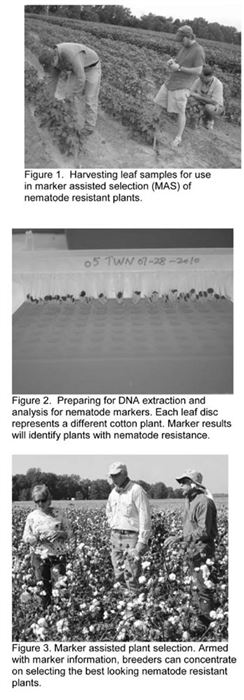Development Of Nematode Resistant Cotton Breeding Lines
MISSISSIPPI STATE, MISS.
Cotton losses attributed to reniform nematodes have increased over recent years, especially in the southeastern states. Unfortunately, the entire species of upland cotton (Gossypium hirsutum) is considered susceptible to the reniform nematode. Although cotton is considered to be somewhat tolerant to root-knot nematodes, few varieties are considered resistant. Management options are available to help alleviate some of the losses associated with nematodes, however, some of these such as crop rotation, are not always a viable option. Options for chemical control are also limited now that Temik ® is no longer available, and conventional nematicides can be cost prohibitive. Genetic resistance would provide an economical alternative to traditional nematode control measures with the potential for significant reductions in yield loss and use of chemicals. A major development in the realm of nematode resistance was announced in 2004 when researchers at Texas A&M acknowledged success in transferring reniform nematode resistance from a wild species of cotton (Gossypium longicalyx) into upland cotton. The successful transfer of resistance into upland cotton, for the first time, made development of reniform resistant upland varieties a real possibility. Reports of stunting and other agronomic shortfalls associated with the original reniform resistant breeding line, designated “Lonren”, have prevented the immediate use of resistance in commercial varieties. A poor choice for use in commercial variety development, breeders have been working to improve the agronomic performance (yield, fiber quality, maturity, etc.) associated with new source of reniform resistance. In 2007, breeders with the Mississippi Agricultural & Forestry Experiment Station (MAFES) began a program aimed at developing nematode resistant breeding lines adapted to the Mid-south utilizing the Lonren source of resistant in addition to root-knot resistant breeding lines. The primary objective of the breeding program is to transfer reniform resistance from Lonren into competitive breeding lines suitable for use in commercial variety development. Another objective is to combine both reniform and rootknot resistance into a single breeding line. Unique breeding challenges are encountered when selecting plants for nematode resistance compared to selection for agronomic traits such as yield and fiber quality. Yield and fiber quality traits, for example, are relatively easy to quantify and can be measured under a wide range environments. Nematodes on the other hand, may or may not be present in the soil, nematode populations can vary widely, and quantifying nematode resistance in the plant can be challenging. Some breeders have utilized stunting, root damage, and yield reductions to measure nematode resistance in cotton with varying success. Nematologists have addressed these challenges by evaluating “potted” plants grown in a greenhouse. A known number of nematodes are added to each pot, and after a given period of time, the number of surviving nematodes is determined. Since nematode reproduction and survival will be reduced on resistant plants, resistance can be quantified in terms of nematode reproduction. Considered the “gold standard” for quantifying and confirming resistance, this time consuming and labor intensive method for measuring resistance is not a practical approach for evaluating the large number of plants encountered in a typical breeding program. Fortunately, a relatively new approach, referred to as marker assisted selection (MAS), allows for the identification and selection of plants that possess the gene(s) conferring nematode resistance. A molecular marker is a unique sequence of DNA found in close proximity to a gene of interest, such as a gene responsible for nematode resistance. Plants possessing the marker have a high probability of being resistant. Presence of the marker (resistant plant), or absence of the marker (susceptible plant), can be determined from the DNA of a small leaf sample. The advantages to MAS are numerous. Since MAS relies upon identification of plants with gene(s) for resistance, resistant plants can be selected regardless of the presence or absence of nematodes. Because a small leaf is all that is needed to provide a sample of DNA, hundreds or even thousands of plants can be sampled in a short period of time with relative ease. Furthermore, MAS can be implemented at any plant stage, from young seedlings to mature plants.

Utilizing this method (MAS), MAFES cotton breeders have evaluated 3,000-5,000 plants each year since 2008. New populations of plants are developed each year via cross pollination of the new reniform resistant line with various varieties and breeding lines, including root-knot nematode resistant lines. Beginning In the second generation following cross pollination, seedlings are tagged for identification, leaf samples collected, and DNA assessed for presence of markers to identify nematode (reniform & rootknot) resistant plants. Prior to harvest, plants that were identified as resistant are considered for selection depending on overall appearance (lack of stunting, number of bolls, branching, etc), hence the term “marker assisted selection”. Each plant selection is then planted to an individual progeny row the following year and evaluated for yield and fiber quality. Best performing progeny rows are then selected for testing in traditional replicated yield trials. Following these procedures have resulted in the selection of 78 nematode resistant breeding lines. Selected lines are scheduled for replicated yield testing In 2011. Breeding lines competitive in agronomic performance will be made available to the cotton breeding community for the development nematode resistant commercial varieties. Δ
DR. TED WALLACE: Cotton Breeder, Mississippi State University